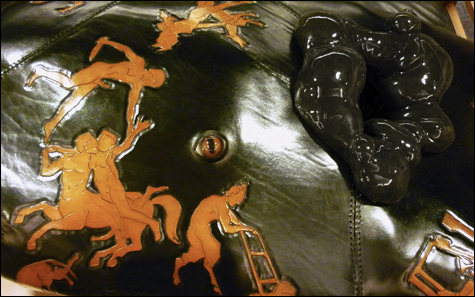
TAKE A CLOSER LOOK ‘Cashmere Roadkill,’ detail, by Greta Bank. |
"Cashmere Roadkill" stretches its flaccid bloat of a body over about 10 feet of bookshelf on the seventh-floor reading room at USM's Glickman Family Library. Greta Bank's modern Prometheus is a maimed assemblage of body parts. A severed torso bubbles with glossy cankers and three spindly appendages reach from its top and bottom tapering to claw-like child hands cast in resin. Schools of glazed taxidermy eyes swell from various locations on the form with an injured, vacant stare, lending the fetid beast an omniscient air of witness.
The flesh of Greta Bank's carcass meets cadaver is hand carved and tooled leather, stained black to emphasize vignettes fashioned in the style of Greek red-figure pottery that weave around the figure. Ochre scenes of centaurs and satyrs engaging in erotic and violent narratives with nude humans and other animals are treated as decorative motifs. The mythical half-breeds mingle with both of their descendants, rendered as haughty bacchanalian egos proudly inciting mischief and destruction among the weak humans that pitifully prey on their animal companions. Bank depicts the ruthless abuse of dogs, horses, deer, and goats — animals we humans domesticate, identify with, and categorize as cute. The exchanges between human and animal are gross confusions of lust and rage. Men and women bear ready axes and scythes with exaggerated genitalia. Everyone seems to have an erection. A rabid dog attacks or embraces an Odalisqued woman, and another woman performs fellatio on a braying horse. Meanwhile Pan impishly mows the lawn.
Bank's "Roadkill" plays martyr to the reckless advantage bestowed upon the human race. The creature's extremities are decorated with a severe Greek meander, which serves to accentuate the connection of the figural narratives and the frank Grecian depictions of society and moral codes on red-figure ware. The meander also evinces the status of the object as decorative, as art, as an object of luxury. The texture and handling of the black leather with visible stitching hearkens to something between a vintage football and a sadomasochistic bondage toy, evoking a quality of play that alters the experience of the work. The three orifices blistering from the corpse's torso open to black cashmere sleeves, inviting a soft reach into the bowels of the body. While the work is "hands off" in this exhibit, the sculpture was originally intended to be interactive. The viewer is meant to enjoy the sensation of touching this metaphor, to find pleasure in running their fingers over the violence in bas-relief and into the smooth cancerous interior. Through interaction, "Roadkill" becomes a puppet, something to act out our fantasies.
Hand-worked leather and cashmere, as materials derived from other animals, speak to human sybaritism and general abuse and exploitation of their world. Roadkill is here a categorical metaphor for human waste and prerogative, a reminder of the overwhelming quantities of unnoticed deaths at the hands of our luxury. The artist describes "our dissociative conscience as we blend with our machines speeding on roadway grids, where different rules apply for our moral code. We are forced to consider roadkill as a necessary compromise." We are instructed not to veer around creatures "stuck in headlights," and the state pays to quietly remove the eyesores from our scenic highways. "Cashmere Roadkill" provocatively confronts the casualties of convenience, begging the viewer to interact with and thus acknowledge their own destructive actions. Heavy-lidded eyes peering back from every angle do not allow a look in the other direction.
Annie Larmon can be reached at aglarmon@gmail.com.
"STORYTELLERS" | through March 12 | 7th floor, Glickman Family Library, University of Southern Maine, Portland | 207.780.4270